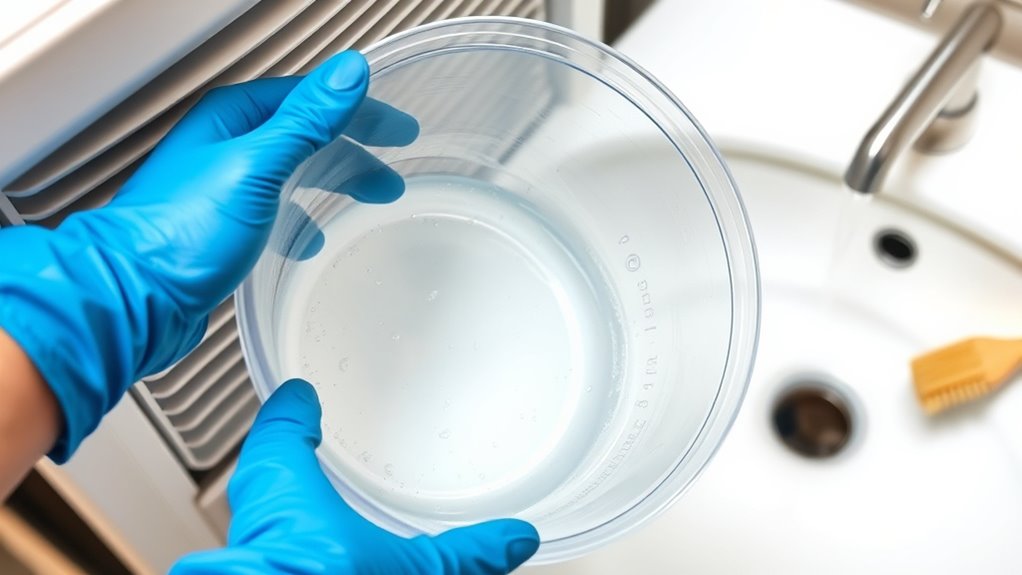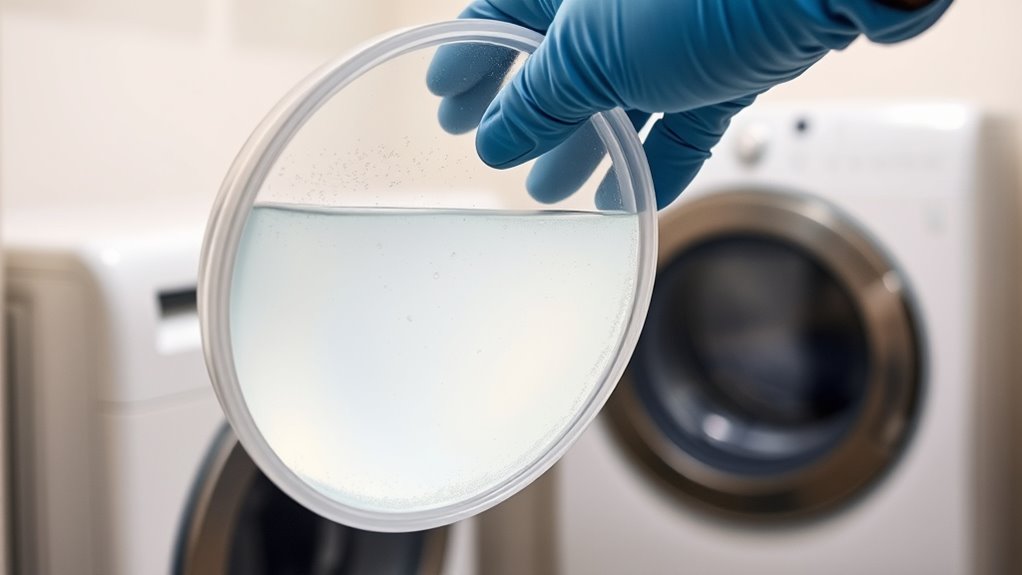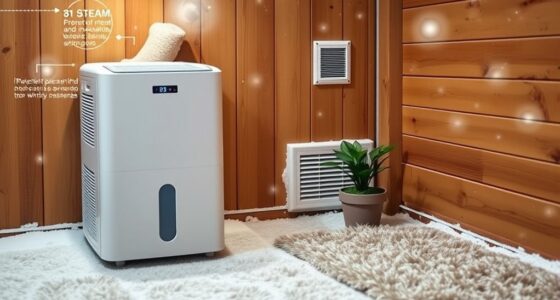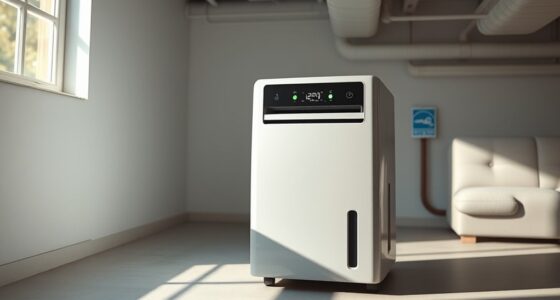To clean your dehumidifier bucket and prevent odors, regularly wash it with mild soap and warm water, then rinse thoroughly. Dry it completely or air-dry to prevent mold and mildew. For extra odor neutralization, add a small amount of white vinegar to the cleaning water. Confirm the filter is clean and the unit is properly placed for ideal airflow. Keep up with maintenance to keep odors away—more tips await to help you maintain freshness.
Key Takeaways
- Regularly empty and clean the bucket with mild soap and warm water, rinsing thoroughly to remove residue.
- Dry the bucket completely after cleaning to prevent mold, mildew, and odor formation.
- Add a small amount of white vinegar to cleaning water for natural odor neutralization.
- Air-dry the bucket fully before reinserting it into the dehumidifier.
- Maintain a clean air filter to reduce debris and prevent odor-causing buildup in the system.

A clean dehumidifier bucket is vital for maintaining your device’s efficiency and preventing mold or bacteria growth. When you regularly clean your bucket, you help guarantee it continues to operate effectively and avoid unpleasant odors. But to keep your dehumidifier running smoothly, you also need to pay attention to air filter maintenance. The air filter plays a key role in trapping dust and debris, which, if left unchecked, can clog the system and reduce its efficiency. Make it a habit to check and replace or clean the air filter as recommended by the manufacturer. Doing so not only improves air quality but also maximizes your unit’s energy efficiency, saving you money on electricity bills.
Energy efficiency tips go hand in hand with proper maintenance routines. When your dehumidifier’s air filter is clean and unobstructed, the device doesn’t have to work as hard to remove moisture from the air. This reduces energy consumption and extends the lifespan of your machine. Additionally, guarantee that the dehumidifier is placed in an ideal spot—away from walls or furniture that could block airflow. Proper placement allows for better air circulation, reducing strain on the compressor and fan, which contributes to energy savings. Regularly inspecting and cleaning your bucket is also part of these energy tips; a dirty or moldy bucket can cause the unit to cycle more frequently, wasting power and increasing wear and tear.
Cleaning the bucket regularly also helps prevent the buildup of rust and corrosion, which can impair the unit’s function over time. When you’re cleaning the bucket, use a solution of mild soap and warm water to remove any buildup. Rinse thoroughly and dry completely before reinstalling. This simple step helps prevent mold and bacteria growth, which can cause foul odors and potentially harm your health. It’s also a good idea to leave the bucket out to air-dry for a while after washing to ensure no residual moisture remains. If you notice persistent smells, consider adding a small amount of white vinegar to the cleaning water; vinegar is effective at neutralizing odors and inhibiting mold growth.
Frequently Asked Questions
How Often Should I Replace My Dehumidifier’s Filter?
You should replace your dehumidifier’s filter according to the recommended replacement schedule, usually every 1 to 3 months. Regular filter maintenance is essential to keep your unit running efficiently and prevent odors. Check your user manual for specific guidance, but don’t wait too long—dirty filters can reduce airflow and affect performance. Staying on top of filter replacement ensures cleaner air and a longer lifespan for your dehumidifier.
Can I Use Bleach to Disinfect the Bucket?
Imagine you’re cleaning your dehumidifier bucket after noticing a musty smell. You might wonder if bleach is safe to disinfect it. While bleach is a strong disinfectant, bleach safety is vital because it can damage plastic and release harmful fumes. Instead, consider disinfectant alternatives like white vinegar or hydrogen peroxide. These options effectively kill mold and bacteria without risking damage or health issues, making your cleaning safer and more eco-friendly.
What Are Signs of Mold Growth in the Bucket?
You’ll notice mold indicators like black, green, or white spots in your dehumidifier bucket. If you detect a musty or moldy smell during smell detection, it’s a sign mold may be growing. Regularly inspecting your bucket helps catch these signs early. If you see mold or smell odor, clean the bucket thoroughly to prevent health issues and keep your dehumidifier functioning effectively.
Is It Safe to Run the Dehumidifier Without the Bucket?
Imagine your dehumidifier working tirelessly, removing moisture from the air. Running it without the bucket might seem tempting, but it’s unsafe. The dehumidifier safety guidelines warn against bucket removal because it can cause water damage or malfunctions. Without the bucket, your device could overheat or leak, risking damage to your home. Always keep the bucket in place to guarantee proper function and avoid costly repairs.
How Can I Prevent Future Odor Buildup Effectively?
To prevent future odor buildup, guarantee good air circulation around your dehumidifier and keep the room well-ventilated. Regularly empty and clean the bucket, and consider using odor absorbers like activated charcoal or baking soda inside it. These steps help neutralize moisture and odor, preventing bacteria growth. By maintaining airflow and using odor absorbers, you’ll keep your dehumidifier smelling fresh and functioning efficiently over time.
Conclusion
Keeping your dehumidifier bucket clean is like tending a garden—you must regularly remove debris to keep things fresh and thriving. By following these simple steps, you prevent odors from creeping in, much like stopping weeds before they take over. Think of your dehumidifier as a loyal companion, working silently to protect your home’s air quality. Stay vigilant with maintenance, and you’ll enjoy a fresher space, just as a well-tended garden rewards you with vibrant blooms.









